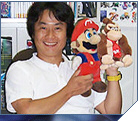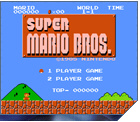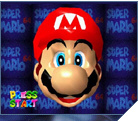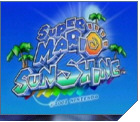 |
|
 |
 |
 |
 
Few industry icons can claim the multitude of phenomenal successes
that Nintendo game designer Shigeru Miyamoto can. Miyamoto's
greatest creation, a character named Mario has reshaped the industry in many ways over
the years. With the coming
launch of Super Mario Sunshine, GameCubicle takes a look back at the
history of Mario, from Miyamoto's first sketch of Mario to the character's
domination of the video game universe...

Shigeru Miyamoto

Shigeru Miyamoto grew up in a modest home in Sonebe, Japan. An
artist from his youngest years, Miyamoto took great joy in drawing
and painting. Miyamoto's interests in art only increased over the years
and he spent much time filling sketch pads with scenes of nature,
creating puppets, constructing
models, and creating lively characters
through cartoon flip-books.

Miyamoto was also an adventurer
and often took
off to explore local creeks, fields, mountains, and forests. On one
of his many outdoor adventures, Miyamoto came upon a dark cave in a
hillside near his home. He eventually got up the nerve to explore it and with a
lantern, climbed inside. Miyamoto still recalls the experience as
one of the most exhilarating of his childhood.

In 1970, Miyamoto began attending Kanazawa Munici College of
Industrial Arts and Crafts. He continued his many hobbies throughout
college and even taught himself to play the guitar. Being
an incessant daydreamer, Miyamoto never paid much attention in his
classes and it took him five years to graduate with a degree in
industrial design.

Following his graduation, Miyamoto asked his father to contact
his old friend Hiroshi
Yamauchi, then president of
Nintendo, to request an interview. Yamauchi hired Miyamoto as Nintendo's first staff artist in 1977.

The Game that
Saved NOA

Recognizing the business opportunities that an
emerging North American arcade market offered, Hiroshi Yamauchi found an imperative in developing an independent
Nintendo subsidiary in North America. In 1977, Yamauchi turned to his
son-in-law Minoru Arakawa to lead the new firm. After much consideration, Arakawa
accepted Yamauchi's offer and moved from
Vancouver to Manhattan where he set up Nintendo of America's
first office.

Arakawa's primary task
was to break Nintendo into America's coin-operated arcade business.
Nintendo of America (NOA) found only failure in its early efforts to
meet this task (see: Space Fever and Sheriff). Impressed by the early success of
a new arcade machine called Radarscope and in desperate need of a
hit, Arakawa boldly ordered 3,000 Radarscope machines. Only
1,000 units sold through to arcade owners and the Radarscope operation
proved disastrous.

Finding little success in the North American arcade market, Nintendo
of America was in a desperate situation.
Arakawa decided it would be best to move the subsidiary's
headquarters closer to NCL and thought Seattle to be the best
location.

With Nintendo's best
designers occupied on more important projects for the Japanese
market, Yamauchi turned to young Nintendo artist Shigeru Miyamoto to
design a coin-op arcade game that would bring success to Nintendo's efforts in
North America. The imaginative Miyamoto conceived a story involving
an angry gorilla that escapes from his master, kidnapping the
master's girlfriend and taking her to the top of a construction
site. Players control the master as he ascends the
building, a factory, and a steel foundation, trying to save his
girlfriend.

 In designing the game's hero, Miyamoto sought to create a silly
character with whom gamers could connect. He designed a pudgy
carpenter with a rounded nose and wide eyes. The low resolution of
video game displays at the time, in addition to hardware
limitations of the Radarscope sets on which Donkey Kong would run,
required Miyamoto to make a few adjustments so that gamers could
discern the character's features. To make the carpenter easily visible, Miyamoto outfitted him with colorful overalls and shirt. A
mustache was drawn in to distinguish the his large nose. Finally, a red cap was added because programmers found it difficult to create
the hair movement that would occur when the character
jumped. In the end, Miyamoto settled on the name Jumpman for the
carpenter and Donkey Kong for his pet gorilla, believing that
'donkey' translated into stubborn or silly in English.
In designing the game's hero, Miyamoto sought to create a silly
character with whom gamers could connect. He designed a pudgy
carpenter with a rounded nose and wide eyes. The low resolution of
video game displays at the time, in addition to hardware
limitations of the Radarscope sets on which Donkey Kong would run,
required Miyamoto to make a few adjustments so that gamers could
discern the character's features. To make the carpenter easily visible, Miyamoto outfitted him with colorful overalls and shirt. A
mustache was drawn in to distinguish the his large nose. Finally, a red cap was added because programmers found it difficult to create
the hair movement that would occur when the character
jumped. In the end, Miyamoto settled on the name Jumpman for the
carpenter and Donkey Kong for his pet gorilla, believing that
'donkey' translated into stubborn or silly in English.

|
|
|

By 1981, Miyamoto had completed Donkey Kong - the game that saved Nintendo of America. While
Yamauchi insisted that the Donkey Kong title remain unchanged, Nintendo of
America was given the task of localizing the game's text for North
America. Arakawa
decided to rename Jumpman after the landlord of NOA's warehouse in
Segali Business Park, Mario Segali. Thus, the name Super Mario was born.
Donkey Kong soon became the fastest selling game that the arcade industry
had ever seen, eventually selling 65,000 units.

In 1983, Mario would title in his own game, Mario Bros. On the
input of a colleague who mentioned the character looked more like a plumber
than a carpenter, Miyamoto decided to change Mario's
profession. In Mario Bros., Mario and his brother Luigi must
clear underground pipes of unwanted pests including crabs, turtles,
and fireflies. Playing cooperatively or against each other, players
had to jump from beneath an enemy to overturn it and then kick it away to
score a gold coin from the piping system. Mario Bros. proved only a
moderate success while in arcades but the best was yet to come.

|
Super Mario

Never at ease with the state of current affairs, Yamauchi sought to
expand Nintendo's business in a substantial way. In May of 1983,
Nintendo launched the Family
Computer - or Famicom. The incredibly innovative home console would lay the foundation of a new pathway
for Nintendo. A technological work of art, Famicom featured
incredible power at an affordable price in a very functional
package. Nintendo sold more than
500,000 Famicoms within two months of the console's launch.

Evaluating Famicom operations, Yamauchi realized the immense importance of software.
"The name of the game is the games." In 1984, Yamauchi
assigned Shigeru Miyamoto to lead R&D4, a new development group within
Nintendo. Miyamoto's single mission was to create the most inventive
video game ever made. He succeeded. The game, Super Mario
Bros., would forever change the video game industry.

|
|
|

Recognizing the early success of Famicom in Japan, Yamauchi wished
to take the console to North America. In mid-1985, Nintendo of
America brought the Nintendo Entertainment System (NES) to New York
City, considered by Nintendo to be one of the most difficult markets
in the nation for video games. Toy retailers at the time still had
memories of the industry's recent implosion fresh in mind. To get consoles onto store
shelves, NOA made the bold move of offering a money-back guarantee to retailers for unsold
merchandise. By the end of the
year 500 retailers in New York City sold half of the 100,000 NES
systems allocated to Nintendo of America. Though it was far from spectacular,
the New York City NES test launch was a success.

Meanwhile in Japan, Super Mario Bros. was
about to be released. In designing the game, Miyamoto borrowed
many ideas from his
childhood experiences and books he had read over the years. Ideas
for hidden blocks, multiple pathways within each level, and underground
passages came from Miyamoto's childhood adventures. His memory of exploring caves
and canyons in Sonebe for example shaped the game's underground levels.
Miyamoto's fascination with the unseen and unexpected weighed into
the addition of pipes to the Mushroom Kingdom. The idea for mushrooms that
increase Mario's stature was taken directly from Alice in Wonderland.

Super Mario Bros. would define a new era in gaming.
Graphically, the colorful world of the Mushroom Kingdom was unlike
anything gamers had ever seen before. Super Mario Bros. was a first in the
side-scroller genre and truly absorbed gamers of all ages in to a
fantastic world that could only have been experienced in a dream.

 When Super Mario Bros. was released in late 1985 it was an immediate
and unprecedented
success. Later that year, Nintendo bundled Super Mario Bros. with
Famicom and console sales increased. Mario was a system-seller. While
Super Mario Bros. was breaking records in Japan, Nintendo was
readying a North American NES launch. While early test launches
suggested moderate success for NES, Mario would arrive in time to
change the equation for NES's national launch in 1986. Mario's
legacy as an icon for the whole of the video game industry
was sealed. In following years, Mario would prove to be the most
valuable name in video game history.
When Super Mario Bros. was released in late 1985 it was an immediate
and unprecedented
success. Later that year, Nintendo bundled Super Mario Bros. with
Famicom and console sales increased. Mario was a system-seller. While
Super Mario Bros. was breaking records in Japan, Nintendo was
readying a North American NES launch. While early test launches
suggested moderate success for NES, Mario would arrive in time to
change the equation for NES's national launch in 1986. Mario's
legacy as an icon for the whole of the video game industry
was sealed. In following years, Mario would prove to be the most
valuable name in video game history.

|
|
|

In 1987, a game titled Dream Factory: Doki Doki Panic was released
in Japan. Developed by Nintendo and Fuji, Doki tells the story of
two children who are pulled by a large green hand into a book they
are reading. Their pet monkey runs to find help from another family
who themselves jump into the the novel. Gamers were then left to
select a family member with whom to progress through the book's
chapters. Doki performed well in Japan and that might have been the
last we heard of the game if it weren't for a hole in Nintendo of
America's holiday release schedule the following year.

With North American demand for a sequel to Super Mario Bros.
peaking, Nintendo bought out Fuji's rights to Doki Doki Panic and
modified the game to feature Mario, Luigi, Princess, and Toad. The game was released
in North America as Super Mario Bros. 2 during the 1988 holiday
season. With vegetables, potions, shyguys, and cactii, SMB2's
gameplay and setting were completely unique from what gamers
experienced with the original SMB. Nevertheless, most gamers enjoyed
the Mario experience just the same.

In Japan, Super Mario Bros. 2 had already been released as a direct sequel to
Super Mario Bros. based on the original game's engine. SMB2 offered slightly improved
graphics and considerably more challenging gameplay. While the game
performed extremely well in Japan, SMB2 was thought to be too
difficult for American gamers at the time. It wouldn't be until 1993
that the game was finally released in
North America as Lost Levels, part of the Super Mario All-Stars SNES
compilation. The American
SMB2 would eventually be released in Japan as Super Mario Bros.
U.S.A.

 It
had been four years since the introduction of Super Mario Bros. when
the game's first true sequel from Shigeru Miyamoto was finally
released in Japan. Featuring eight worlds, each containing numerous
levels, the game used an innovative map navigation system and was
the largest in the series yet. The game's story was very familiar. Bowser has captured the Princess and taken over the Mushroom
Kingdom. His seven children have stolen the royal wands of each
world. It
had been four years since the introduction of Super Mario Bros. when
the game's first true sequel from Shigeru Miyamoto was finally
released in Japan. Featuring eight worlds, each containing numerous
levels, the game used an innovative map navigation system and was
the largest in the series yet. The game's story was very familiar. Bowser has captured the Princess and taken over the Mushroom
Kingdom. His seven children have stolen the royal wands of each
world.
While staying true to the format of the original, SMB3 introduced new
gameplay elements including special
suits that gave Mario new abilities. The Tanooki Suit for example
gave Mario the ability to turn into a statue, the
Sledgehammer suit let Mario throw hammers, and the Frog Suit
enhanced Mario's swimming and jumping skills. Mario could also fly
with a cute raccoon tail and find warp whistles carefully hidden in
certain levels. Super Mario Bros. 3 is considered by many to be the
best Mario game in the series.

The first that most North American gamers got to see of Super Mario Bros.
3 was in The Wizard, a movie about a child video game prodigy who
travels with his brother to the West coast, where he competes in a
national video game contest. The film culminates in the unveiling of
Super Mario Bros. 3. Nintendo's marketing effort was flawless and
demand for the game at launch was more than even Nintendo
anticipated. Super Mario Bros. 3 remained sold out for months after
its North American release. According to a national survey in 1990, Mario was more recognizable among
American youths than Mickey Mouse.

|
|
|

 In the same year,
Nintendo was beginning to face serious
competition in the video game industry. Distracted by its own success, Nintendo stood on the sidelines as NEC and Sega introduced
their respective '16-bit' consoles. Nintendo's Masayuki Eumura had
been working on a follow-up to Famicom for years by this time but
with NES sales strong as ever, Nintendo saw no imperative in
hastening the new console's launch. In the same year,
Nintendo was beginning to face serious
competition in the video game industry. Distracted by its own success, Nintendo stood on the sidelines as NEC and Sega introduced
their respective '16-bit' consoles. Nintendo's Masayuki Eumura had
been working on a follow-up to Famicom for years by this time but
with NES sales strong as ever, Nintendo saw no imperative in
hastening the new console's launch.
Both TurboGraphx and Sega Genesis were on the market for more than a
year before Nintendo's Super Famicom was ready for release. Yamauchi
realized that Nintendo needed to offer consumers a compelling reason
to invest in a new video game console - especially one that was not compatible
with existing software. He turned to Shigeru Miyamoto for a game
that would show off the processing power of the new console and sell
systems.
Miyamoto created Super Mario World. In this adventure, Mario and
Luigi take off for a
vacation on Dinosaur Island to recuperate from their adventures when
they finds out that the Princess has again disappeared. Mario
must head out across Dinosaur Island's seventy-four levels to find
the Princess and save Yoshi's friends. The game was non-linear and
certain levels even had to be played multiple times to find hidden
keys that opened new roads on the overworld
map. Landscape changing switch blocks were added to the game adding
replay value to each level. Super Mario World also introduced Yoshi, a little
green dinosaur
that provides protection and transport for Mario. While the game
truly demonstrated Super Famicom's technical abilities, Super Mario World was
ultimately not as great of a leap from Super Mario Bros. 3 as it
could have been. Nevertheless, it was a massive success.
In Japan, there were an astounding 1.5 million retail orders for
Super Famicom at launch. The console and games had
to be shipped to retailers in secret. When the console was finally
launched, shortages were so severe that near-riots were reported at
some video game stores.

|
|
|

A New Dimension

Since the moment Miyamoto made his first sketch of Mario, the
character existed in only two dimensions. After fifteen years,
there was a paradigm shift in the Mushroom Kingdom. Mario and the
whole of his universe was rendered in three dimensions. Controlled with a 360º analog
stick, Mario could run, walk, jump, or tip-toe through vast
non-linear levels of Super Mario 64. As he had done years before
with Super Mario Bros., Miyamoto again defined a new genre in
gaming, the 3D platformer.

Although the title's gameplay significantly changed, the storyline
did not... Bowser has again kidnapped the Princess and stolen the
Power Stars that protect Mushroom Castle. Providing for the game's
overworld structure, Bowser hides the stars inside the castle's
paintings. Mario must enter paintings and recapture the stars to
progress through the game. Like Super Mario Bros. on the NES, Super
Mario 64 was a giant leap for console gaming. Yet despite the new
format, Super Mario 64 offered an experience remarkably similar to
earlier Mario games.

 Super
Mario 64 would be the launch title for Nintendo's 64-bit home
console entry, Nintendo 64. With few games available at launch, the
success of Nintendo 64 depended on Mario. Nintendo's famous launch
advertisement read, "On September 30th, Dinosaurs will
Fly." Fly they did. Super Mario 64 sold one to one
with Nintendo 64 throughout the console's launch period and the
console broke all
outstanding launch records at the time in Japan and North America. If there ever was a
"system-selling" title, it was Super Mario 64. Nintendo 64's installed base grew
to 4 million by the end of 1996 on the shoulders of one game. Super
Mario 64 would be the launch title for Nintendo's 64-bit home
console entry, Nintendo 64. With few games available at launch, the
success of Nintendo 64 depended on Mario. Nintendo's famous launch
advertisement read, "On September 30th, Dinosaurs will
Fly." Fly they did. Super Mario 64 sold one to one
with Nintendo 64 throughout the console's launch period and the
console broke all
outstanding launch records at the time in Japan and North America. If there ever was a
"system-selling" title, it was Super Mario 64. Nintendo 64's installed base grew
to 4 million by the end of 1996 on the shoulders of one game.

With the transition to three dimensions came distinctive
evolution in Nintendo's approach to game design. "In the old days, Miyamoto created
puzzles then built screens around them," describes industry
expert Steven Kent
in an article on Shigeru Miyamoto. Because
of the growth in sophistication of games for modern consoles, Miyamoto
finds "it is often easier to create landscapes and
then figure out what to do with them." One example Miyamoto
offers is Cool Cool Mountain from Mario 64. "We wanted to make
a snowy mountain in Mario 64 - a really big one. That came first,
and afterward we talked about ideas of how to make use of this
mountain."

|
Mario's
Success

In the last twenty years, over 160 million Mario games have been sold. Topping
the list, more than 40 million copies of Super Mario Bros. were sold on the NES and
20.6 million copies of Super Mario World on SNES. However, because these games were bundled with
console hardware, their sales may not be fairly compared to other
games. To this day Super Mario Bros. 3 remains the best-selling video game of all time
never bundled with console hardware, having sold 17.28 million copies.
For additional information, click the Mario Sales link below.

The Mario brand has proven to be a priceless asset to Nintendo. The franchise has been branched out into an number of
games over the years. Dr. Mario, Mario Golf, Mario Kart, Mario Party, Mario Tennis,
Mario RPG, and Mario Paint, to name a few. Over
the years, Mario's products have come to include cartoon shows,
movies, books, hats, plush dolls, cereals, t-shirts, lunch boxes, ice
cream, bedding, kitchenware, clocks, and the list goes on. Mario has
even appeared on the cover of Nintendo Power eighteen times - more than any
other character.

Mario's legacy continues to grow every year. As Super Mario Sunshine climbs the list of
best-selling Mario games, additional titles are still on their way.
Hudson's Mario Party 4 improves upon the classic series first
introduced on the Nintendo 64. Meanwhile, Mario Tennis and Mario
Golf are under development at Camelot Software for release on
GameCube sometime next year. Mario's history may already be set in
stone but Nintendo has every intention of seeing Mario games
dominate the sales charts for years to come.

|
|
|

Super Mario Sunshine

Nintendo GameCube was the first video game console launched
worldwide by Nintendo without the support of a Mario game.
With the launch of Super Mario Sunshine, Nintendo will begin the most aggressive assault it's
ever mounted to win back its position the video game industry. At
this year's Electronics Entertainment Expo, Nintendo introduced Game
Giants - a reference to their strongest franchises - as their focal
strategy to dominating this year's holiday season. Super Mario
Sunshine will be the first to the forefront, followed by Star Fox
Adventures, Metroid Prime, and the Legend of Zelda.

 In Super Mario Sunshine,
entirely new
game elements are combined with classic Mario gameplay to create one of the most
unique and enjoyable Mario adventures yet. The storyline of Super Mario Sunshine is much different than
previous games in the series. The adventure begins when Mario and Peach decide to take a vacation to
the beautiful Dolphic Island. When the couple arrives on the island,
they notice
ugly scribble marks covering the walls throughout the community.
What's worse, the person responsible for the scribbling has
disguised himself to look just like Mario. Falsely accused
by the locals, Mario decides to investigate the situation. Armed
with a new water-pumping backpack, Mario climbs trees, wall jumps off
buildings, hangs from gates, walks on on tightropes, and swims
through coral reefs on his quest to reveal the identity of the true villain. In Super Mario Sunshine,
entirely new
game elements are combined with classic Mario gameplay to create one of the most
unique and enjoyable Mario adventures yet. The storyline of Super Mario Sunshine is much different than
previous games in the series. The adventure begins when Mario and Peach decide to take a vacation to
the beautiful Dolphic Island. When the couple arrives on the island,
they notice
ugly scribble marks covering the walls throughout the community.
What's worse, the person responsible for the scribbling has
disguised himself to look just like Mario. Falsely accused
by the locals, Mario decides to investigate the situation. Armed
with a new water-pumping backpack, Mario climbs trees, wall jumps off
buildings, hangs from gates, walks on on tightropes, and swims
through coral reefs on his quest to reveal the identity of the true villain.

|
|
|

The truly defining aspect of Super Mario Sunshine's is
unquestionably Mario's new water backpack, named F.L.U.D.D.
The idea for Mario's water backpack came from Yoshiaki Koizumi,
Director of Super Mario Sunshine. Like the special suits
and hats of earlier Mario games, the
inventive devise adds an entirely new dynamic to Mario's adventure
and allows for many new gameplay elements. The backpack can be toggled to
spray a stream of water in any
direction or shoot downward to propel Mario into the air. Mario can use both
backpack functions to clear sludge and defeat enemies. Enabling Mario to
hover for extended lengths, the pack also greatly increases Mario's
mobility. Later in the game, additional nozzles can be found, giving
Mario the ability to perform incredibly high jumps and propel himself
around levels. Players will also have to worry about conserving water and
finding locations to refill Mario's backpack.

|
|
|

After an eleven year absence, Mario's close friend Yoshi finally
returns in Super Mario Sunshine. Yoshi speeds along Mario's quest
and even adds additional depth to the game's gameplay. Like the
meter on Mario's backpack, Yoshi now carries a juice meter that
gradually runs out as Mario rides him. The meter can be replenished by
feeding him fruit. Yoshi can even throw up fruit punch for some humorous ends.

 Sunshine's controls are easy to pick up and very responsive. The
basic system is derived from Super Mario 64 and the button layout is
near flawless. In many respects, GameCube's controller almost seems
like it was designed for this
game. Mario's
transition into three dimensions brought with it
some difficulties first seen in Mario 64. The camera system
in particular is still somewhat of an obstacle and is perhaps the game's only significant flaw.
While game designers wanted to give players near autonomous control
over the camera system, the system's occasional failure to
auto-correct can be
very frustrating.
Sunshine's controls are easy to pick up and very responsive. The
basic system is derived from Super Mario 64 and the button layout is
near flawless. In many respects, GameCube's controller almost seems
like it was designed for this
game. Mario's
transition into three dimensions brought with it
some difficulties first seen in Mario 64. The camera system
in particular is still somewhat of an obstacle and is perhaps the game's only significant flaw.
While game designers wanted to give players near autonomous control
over the camera system, the system's occasional failure to
auto-correct can be
very frustrating.

Mario's water backpack serves to resolve at least one
control issue by improving the gamer's ability to manipulate Mario as he jumps from
one platform
to another. Miyamoto explains, "Making precise movements, such
as jumping, are not easy in 3D games... Hovering contributes to the
smooth play." Because the game's designers felt the water
backpack could make certain levels too easy to navigate, use of the
tool is
limited in some areas of the game.

Graphically, Super Mario Sunshine is somewhat varied. At times the
game can be less than impressive. However, Miyamoto created Mario's
environment to been one of fantasy and imagination so any
expectation that the game's appearance should have rivaled the likes
of Star Fox
Adventures would be
unfair. This is not to say that Super Mario Sunshine's graphics
aren't beautiful.
The game's colorful worlds have a life of their own and are
incredibly fun to
explore. From any point in a level, Mario can see structures and
animated characters clear to the horizon. Additionally, the real-time lighting effects
in the game are nothing
short of spectacular. Keep an eye out for free moving
fully-reflective surfaces. The sludge, water, and heat wave effects are also
beautifully designed and very
entertaining.

Overall, Super Mario Sunshine can be viewed as Mario 64 taken to the
next level in every possible respect. The new environments of
Dolphic Island in addition to Mario's water backpack create an
entirely new feel to the Mario experience, which is looking to be
the best yet.

|
|
|

Super Mario Sunshine may not be Mario's only adventure on GameCube
though.
According to Nintendo, Mario could be returning for a second time
around sooner than you might expect. When designing Super Mario
Sunshine, Nintendo established a new GameCube development system that
permits for significantly reduced game project times. According to Miyamoto, once the system was created,
Super Mario Sunshine took only a year and a half to develop. In a recent interview Miyamoto expressed great
interest in developing another Super Mario game for GameCube and
commented that key designers of the Mario series have been divided
into several teams, "in order to introduce Mario series games
with less lag time between them."
 |
|
Rick - Editor in
Chief, GameCubicle
|

|
|
 |
 |
|

Article References

Kent, Steven L. "If Shakespeare Made Games." The Japan
Times. Tokyo, Japan. June 7, 2001.

Kent, Steven L. The First Quarter: A 25-Year History of Video
Games. BWD Press, Washington. 2000.

Nintendo Power. Nintendo of
America, Washington. 1988-2002.

Sheff, David. Game Over: How Nintendo Zapped an American
Industry, Captured Your Dollars and Enslaved Your
Children. Random House, New York. 1993.

|
|
 |

|
|
 |
|
 |

